

by Keavin Wiggins

“Sing me a
song, you're the singer....”
 Whether he goes down as the “Man on the Silver Mountain,” the sinner who
sang us a song, “The Last In Line,” The Killer of the Dragon or the “Holy
Diver,” Ronnie James Dio has definitely earned his place in the history
books of rock n roll as a metal legend.
Whether he goes down as the “Man on the Silver Mountain,” the sinner who
sang us a song, “The Last In Line,” The Killer of the Dragon or the “Holy
Diver,” Ronnie James Dio has definitely earned his place in the history
books of rock n roll as a metal legend.
Even to this day, he continues to win over
new generations of metalheads with the wealth of material he has produced
over the years. It is that catalog of material that Warner Brothers and
Rhino Records drew from to create the new definitive Dio career retrospective
“Stand Up and Shout”. With the release of this special two disc anthology
set that features music from every era of his career as a recording artist,
we thought it was about time that we did a feature article on Ronnie James
Dio.
 Ronnie James Dio was born Ronald James Padovona in New England, on July
10, 1949. Like a lot of children of the post World War II era, he grew
up with the backdrop of Rock n Roll as the soundtrack to his adolescence.
Ronnie took to music right away and began his pursuit as a performer at
a young age, playing bass guitar and the trumpet in one of his early bands
The Vegas Kings. Like most rock stars to be, Ronnie cut his teeth
with a handful of different bands before settling down into the one that
would give him his first big break. In the late 60’s he was playing
with a band called the Electric Elves, who composed rock and folk music
that was the style of the time. By the dawn of the new decade the band
had changed their name to Elf and Ronnie was now going by the name Ronnie
Dio. They caught a lucky break when Deep Purple’s Roger Glover and Ian
Paice caught the band during an audition for Columbia records. With a record
deal in place Glover and Paice signed on to produce the band’s self-titled
debut album.
Ronnie James Dio was born Ronald James Padovona in New England, on July
10, 1949. Like a lot of children of the post World War II era, he grew
up with the backdrop of Rock n Roll as the soundtrack to his adolescence.
Ronnie took to music right away and began his pursuit as a performer at
a young age, playing bass guitar and the trumpet in one of his early bands
The Vegas Kings. Like most rock stars to be, Ronnie cut his teeth
with a handful of different bands before settling down into the one that
would give him his first big break. In the late 60’s he was playing
with a band called the Electric Elves, who composed rock and folk music
that was the style of the time. By the dawn of the new decade the band
had changed their name to Elf and Ronnie was now going by the name Ronnie
Dio. They caught a lucky break when Deep Purple’s Roger Glover and Ian
Paice caught the band during an audition for Columbia records. With a record
deal in place Glover and Paice signed on to produce the band’s self-titled
debut album.
Looking back, the music of Elf wasn’t what
we would later come to expect from Dio. The group fell more easily into
the 60’s/70’s rock vibe of the harder edged material from the Rolling
Stones than Black Sabbath or Led Zeppelin, but one element stuck out even
from the beginning; Ronnie’s strong and unique vocals.
 With an album release under there belt, Elf hit the road with Deep Purple.
But for some reason, the band never really took off commercially. There
were also changes underway within the band at that point. Original guitarist
David Feinstein was replaced by Steve Edwards and Ronnie wanted to give
his full attention to his vocals, so the group brought in a new member
to handle bass duties, Craig Gruber.
With an album release under there belt, Elf hit the road with Deep Purple.
But for some reason, the band never really took off commercially. There
were also changes underway within the band at that point. Original guitarist
David Feinstein was replaced by Steve Edwards and Ronnie wanted to give
his full attention to his vocals, so the group brought in a new member
to handle bass duties, Craig Gruber.
With the lineup in place in 1974, Elf,
who had been released from their deal with Columbia, signed a new deal
in the US with MGM Records and with Deep Purple’s label Purple Records
in the U.K. In early 1974 the band traveled to England to record their
second album and once again Roger Glover handled production duties and
the band’s sound started to go more in the direction of Deep Purple.
That album hit in late 1974 entitled “Carolina
Country Ball” in the UK and “L.A. / 59” in the U.S. Once again Elf hit
the road supporting Deep Purple in North America but also the U.K.
Ronnie and Elfs’ keyboardist Mickey Lee
Soule also branched out a bit and took part in Roger Glover's solo project
“Butterfly Ball And The Grasshopper's Feast”.
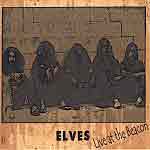 Over the next couple of years, Ronnie would divide his time between Elf
and participating in side projects. The full band went into the studio
to back Deep Purple guitarist Ritchie Blackmore on the single “Black Sheep
Of The Family”. A short time later, Blackmore contacted Dio to see if he
was interested in recording together again. That night Ronnie sat down
and wrote a new track called “Sixteenth Century Greensleeves”, and went
into the studio with Blackmore to record it.
Over the next couple of years, Ronnie would divide his time between Elf
and participating in side projects. The full band went into the studio
to back Deep Purple guitarist Ritchie Blackmore on the single “Black Sheep
Of The Family”. A short time later, Blackmore contacted Dio to see if he
was interested in recording together again. That night Ronnie sat down
and wrote a new track called “Sixteenth Century Greensleeves”, and went
into the studio with Blackmore to record it.
Nothing ever came of the song, which was
rumored to be intended as a b-side to the “Black Sheep of the Family” single.
But the seeds of partnership were planted between Ronnie and Ritchie Blackmore.
In early 1975 the band added percussionist
Mark Nauseef and returned to England to record their third album with Glover
once again producing. Shortly after the band finished recording the
album, they split up.
The group minus guitarist Steve Edwards
and percussionist Mark Nauseef, joined forces with Deep Purple’s Ritchie
Blackmore and formed Rainbow. At that point Ronnie supposedly began incorporating
his middle name into his stage name, at the suggestion of Blackmore.
 For marketing reasons, the group was originally dubbed Ritchie Blackmore’s
Rainbow. With Rainbow, Ronnie made the full transition to metal frontman.
The group entered a German recording studio in late February 1974 and emerged
three weeks later with their self-titled debut, which Blackmore and Dio
coproduced with Martin Birch. (Iron Maiden fans should recognize Birch’s
name.)
For marketing reasons, the group was originally dubbed Ritchie Blackmore’s
Rainbow. With Rainbow, Ronnie made the full transition to metal frontman.
The group entered a German recording studio in late February 1974 and emerged
three weeks later with their self-titled debut, which Blackmore and Dio
coproduced with Martin Birch. (Iron Maiden fans should recognize Birch’s
name.)
Unlike Elf, which never caught on commercially
in a big way, Rainbow was an instant hit. The single "Man on the Silver
Mountain," raced up the charts and put the group firmly on the map. UK
Elf fans hoping to get their hands on the third LP the band had completed
before splitting up were out of luck as the album was held back, so it
wouldn’t conflict with the release of “Ritchie Blackmore's Rainbow”.
The combination of Blackmore’s guitars
and Dio’s vocals made for a powerful frontline for Rainbow. But the duo
felt some changes were needed with the other members of the group. The
first member to be fired was bassist Craig Grubber, who was replaced by
Jimmy Bain and shortly afterwards Cozy Powell took over for drummer Gary
Driscoll.
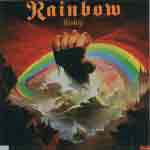 By the time the band hit the road in late 1975, the lineup had solidified
with keyboardist Tony Carey replacing Mickey Lee Soule. The band, which
at this point had shortened their name to just Rainbow, entered Musicland
studios in February of 1976 to record their sophomore album “Rainbow Rising”.
The album title seemed appropriate as the band’s fame and popularity was
going through the stratosphere, making them one of the most popular concert
draws of the day.
By the time the band hit the road in late 1975, the lineup had solidified
with keyboardist Tony Carey replacing Mickey Lee Soule. The band, which
at this point had shortened their name to just Rainbow, entered Musicland
studios in February of 1976 to record their sophomore album “Rainbow Rising”.
The album title seemed appropriate as the band’s fame and popularity was
going through the stratosphere, making them one of the most popular concert
draws of the day.
The group’s explosive live performance
was captured on the best selling live album, “On Stage,” which was released
in 1977. More lineup changes were in order for the group when they entered
the studio once again. This time they were joined by bassist Bob Daisley
and keyboardist David Stone to produce the critically acclaimed “Long Live
Rock'n'Roll”.
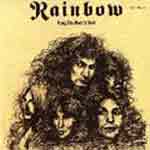 After the title track from the album became a big hit for the group, Dio
and Blackmore began to have intense disagreements over the direction of
the band. Blackmore wanted a more mainstream approach, while Dio wanted
to stay true to the original formula of the group. It all came to a head
in November 1978 when Blackmore reportedly fired the entire band, with
the exception of Cozy Powell. (some reports say that Dio quit).
After the title track from the album became a big hit for the group, Dio
and Blackmore began to have intense disagreements over the direction of
the band. Blackmore wanted a more mainstream approach, while Dio wanted
to stay true to the original formula of the group. It all came to a head
in November 1978 when Blackmore reportedly fired the entire band, with
the exception of Cozy Powell. (some reports say that Dio quit).
Ronnie didn’t have to wait long for a new
gig. While he was considering launching a solo project the dream gig fell
into his lap. Ozzy Osbourne had just been ousted from Black Sabbath and
Tony Iommi was looking for a replacement.
Ronnie had recently relocated to Los Angeles
and he was asked to visit Iommi’s Beverly Hills home to audition. Legend
has it that things went so well during that first visit with Iommi that
Ronnie wrote most of what was to become the classic “Children Of The Sea”,
at that session.
There is some speculation that the band
was originally going to be called Sabbath, since both Ozzy and Geezer Butler
were not involved. However, once Geezer came back, the group went back
to the full Black Sabbath name.
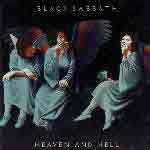 Filling the shoes of a legendary vocalist like Ozzy Osbourne is not easy
but Ronnie stood up to the challenge and together with his new band mates
produced what is arguably one of the best Black Sabbath albums ever released,
“Heaven And Hell”.
Filling the shoes of a legendary vocalist like Ozzy Osbourne is not easy
but Ronnie stood up to the challenge and together with his new band mates
produced what is arguably one of the best Black Sabbath albums ever released,
“Heaven And Hell”.
The fans and critics welcomed the change
and as a result the album was really successful. In the fall of 1980 Black
Sabbath teamed up with Blue Oyster Cult for a co-headlining North American
tour dubbed the “Black & Blue” tour.
The tour was major success with the exception
of a riot that occurred on October 9th, 1980 at Mecca Arena in Milwaukee.
After the band left the road they returned to the studio to begin recording
a new album, “Mob Rules”, with Vinnie Appice replacing Bill Ward on drums. 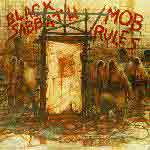
This album was again embraced by critics
and fans and continued the magic the group had produced together on “Heaven
and Hell”. But all was not well in Sabbath land. Infighting and bickering
began between the veteran members of the group and the newest members.
Things came to a head in October of 1982,
while the new live album, “Live Evil,” was being mixed by Geezer and Iommi.
Dio and Appice left the group to form 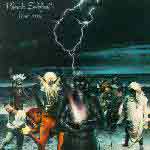 Dio’s solo band. Soon after, accusations began to fly that Dio and Appice
had secretly entering the studio and lowered the mix on the guitars and
bass. However, Iommi later rescinded those claims.
Dio’s solo band. Soon after, accusations began to fly that Dio and Appice
had secretly entering the studio and lowered the mix on the guitars and
bass. However, Iommi later rescinded those claims.
Dio and Appice recruited lead guitarist
Vivian Campbell and bassist Jimmy Bain to help complete their new group
which they called DIO.
Ronnie struck gold again with this group
and their debut album, “Holy Diver”, not only produced such classics as
“Rainbow In The Dark,” “Stand Up and Shout,” and of course the title track,
“Holy Diver,” it also firmly established Dio as a solo artist. 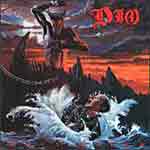
The fans ate it up, as the themes woven
by Ronnie in the songs on “Holy Diver” were familiar from his earlier work
and it also showed just how much influence he did have in songwriting with
his previous bands.
Dio crafted his new songs with a little
more commercial appeal, which opened a lot of doors to new fans. The relatively
new medium of MTV helped by showing videos for “Rainbow In The Dark” and
“Holy Diver”, and both songs, especially the former appealed to hard rock
radio programmers who helped expose Dio’s music beyond his built in audience
and that, along with a successful arena tour, propelled the album to platinum
sales.
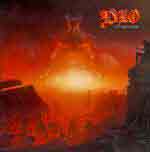 Dio wasn’t a band to rest on their laurels; they followed up their debut
a year later with “The Last In Line”. The demonic imagery of the album
cover translated well into the video for the title track and MTV jumped
all over it. Again, Dio managed to craft a true metal album that also had
a commercial appeal. By the time the second single, “Mystery”, had made
its run and the band had completed another arena tour, Dio was firmly established
as one of the leading metal bands of the era.
Dio wasn’t a band to rest on their laurels; they followed up their debut
a year later with “The Last In Line”. The demonic imagery of the album
cover translated well into the video for the title track and MTV jumped
all over it. Again, Dio managed to craft a true metal album that also had
a commercial appeal. By the time the second single, “Mystery”, had made
its run and the band had completed another arena tour, Dio was firmly established
as one of the leading metal bands of the era.
Dio got further propelled into the mainstream
spotlight in 1985 when they were asked to contribute a song to the “Vision
Quest” soundtrack. Madonna’s hit single from the album, “Crazy for You”,
inadvertently helped turn an even more mainstream audience onto Dio.
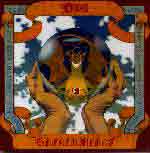 But that single couldn’t help Dio’s third album which was released shortly
afterwards. Dio had effectively avoided the “sophomore” slump with
“Last In Line” but the follow up album, “Sacred Heart” fell flat.
But that single couldn’t help Dio’s third album which was released shortly
afterwards. Dio had effectively avoided the “sophomore” slump with
“Last In Line” but the follow up album, “Sacred Heart” fell flat.
To many, “Sacred Heart” was a bit too commercial
and Dio abandoned the unifying themes of their first two albums.
The thematic elements used in the album were, to many critics, overdone.
The title track was an attempted epic at six and half minutes long that
had promising elements to it but seemed to fail in the execution. The single
“Rock 'N' Roll Children,” didn’t have the spark of earlier Dio hits and
sounded a bit too formulaic to hardcore fans.
.

Click
here for the conclusion
Live Photos by Keavin
Wiggins
Copyright 2003 - All
Rights Reserved
|

